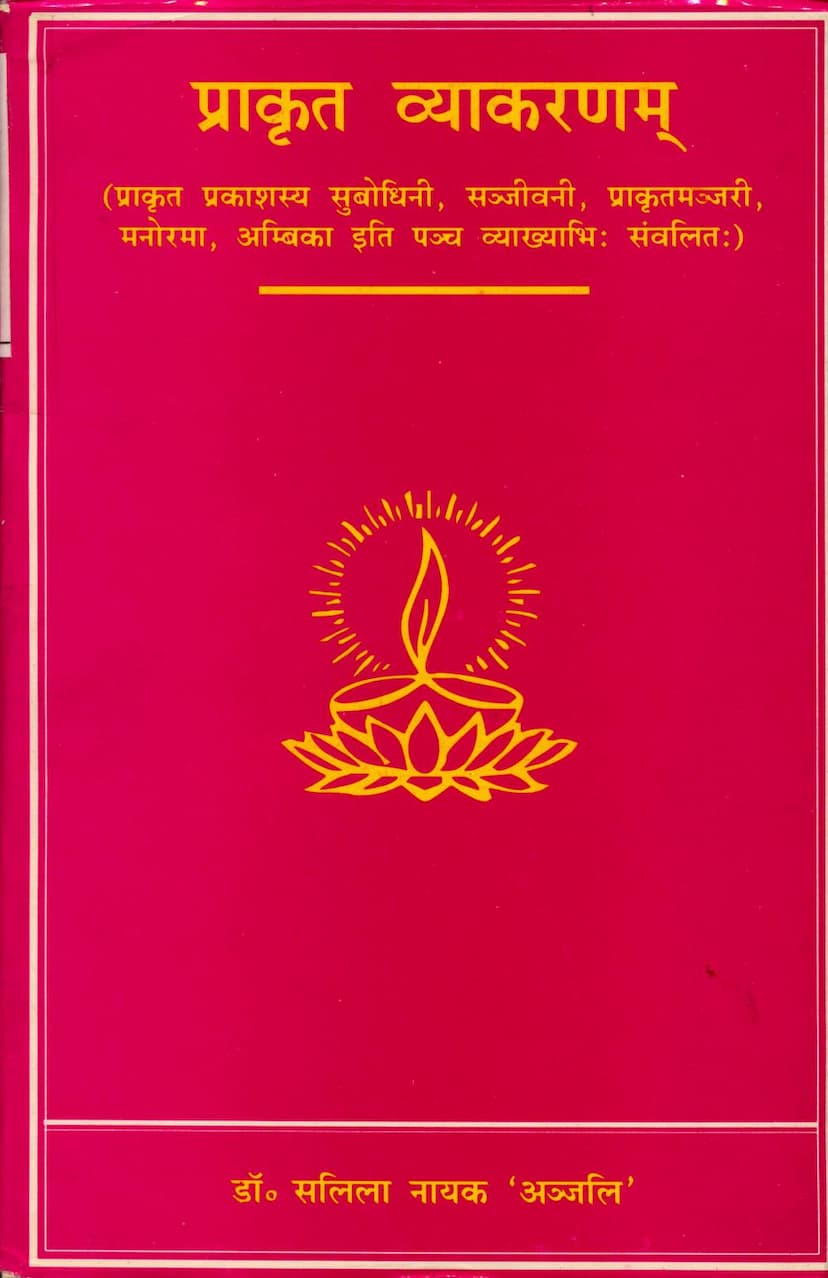Prakrit Vyakaranam
Added to library: September 2, 2025

Summary
This is a comprehensive summary of the Jain text "Prakrit Vyakaranam" by Salila Nayak, published by Pratibha Prakashan, based on the provided pages and catalog link:
Book Title: Prakrit Vyakaranam (प्राकृत व्याकरणम्) Author: Dr. Salila Nayak 'Anjali' (डॉ. सलिला नायक 'अञ्जलि') Publisher: Pratibha Prakashan, Delhi Special Feature: This grammar is enriched with five commentaries: Subodhini (सुबोधिनी), Sanjivani (सञ्जीवनी), Prakritamanjari (प्राकृतमञ्जरी), Manorama (मनोरमा), and Ambika (अम्बिका).
Core Concept and Etymology of "Prakrit":
The text begins by exploring the meaning and origin of the term "Prakrit." It presents two main interpretations:
- From Sanskrit: The most prevalent view among Prakrit grammarians is that "Prakrit" derives from Sanskrit, meaning "that which comes from Sanskrit."
- From Nature/Natural Utterance: Historians suggest that "Prakrit" refers to language spoken naturally, without formal education or refinement.
The author acknowledges the historical perspective, citing the 9th-century poet Vākpati (वाक्पति) in his "Gauda Vaho" (गौड़वहो) who considered Prakrit the origin point of all languages.
Nature of Prakrit Language:
- Prakrit is characterized by its natural and unrefined speech, making it easily understandable and pronounceable by the common people.
- It is noted for its simpler phonetic structure compared to Sanskrit, often omitting complex conjunct consonants found in Sanskrit. For example, Sanskrit "ashta" becomes Prakrit "aath," and "sapta" becomes "saat."
- The "repha" (रेफ - the 'r' sound) often disappears in Prakrit when transitioning from Sanskrit.
Significance and Novelty of the Book:
- The book is presented as a highly innovative work, particularly because it combines the grammatical rules and systematic derivations of Prakrit words (with sutras) with five distinct commentaries.
- Dr. Salila Nayak's work aims to simplify Prakrit grammar, making it accessible to students who might otherwise find it challenging.
- The author intends to revive the practical use of Prakrit in modern times and draw students to its study.
Structure and Content of the Book:
The book is divided into two main parts:
-
Purvardha (पूर्वार्ध - First Part): This section provides introductory and foundational knowledge for students. It covers:
- The meaning and definition of the word "Prakrit."
- The glory and significance of the Prakrit language.
- The ancient scholars of Prakrit grammar.
- The different groups of Prakrit languages and their mutual differences (including epigraphic Prakrit, literary Prakrit, and Jain Prakrit).
- The tradition and history of Prakrit grammar.
- The special features of the "Prakritprakash" (प्राकृतप्रकाश) text itself.
-
Uttarardha (उत्तरार्ध - Second Part): This is the main grammatical section, focusing on the "Prakritprakash" (प्राकृतप्रकाश), likely a foundational text. It presents the rules and their derivations with the help of the five commentaries. The text indicates that the first two chapters (Adhividhi - अज्विधिः and Ayukta Vidhi - अयुक्तविधिः) of Prakritprakash are covered in detail, with all sutras and their examples rigorously analyzed and explained.
Key Grammatical Concepts Discussed (Early Sections):
- Adhividhi (अज्विधिः - Chapter 1): This chapter deals with vowel changes, particularly focusing on the transformation of initial vowels in various words, often influenced by the presence of other sounds or grammatical categories. Examples include the change of initial 'a' to 'aa' (e.g., samriddhiḥ > sāmiddhī), the change of certain vowels to 'i' (īṣat > isi), and the modification of 'a' to 'o' in specific contexts (badara > boro). It also covers the treatment of specific words and suffixes.
- Ayukta Vidhi (अयुक्तविधिः - Chapter 2): This chapter focuses on the treatment of consonants, particularly those that are not conjunct or are in weak positions. It details rules regarding the deletion or alteration of consonants like 'k', 'g', 'c', 'j', 't', 'd', 'p', 'y', 'v' (lokaprakṛti > lokaprakṛti), the change of certain consonants to 'h' (khagathadhambhāṁ haḥ), and the common softening of consonants. It also discusses specific rules for sounds like 'r', 's', 'ṣ', 'ś', 'h', 'l', and the treatment of conjunct consonants.
Commentaries:
The book is distinguished by its inclusion of five commentaries, offering diverse perspectives and detailed explanations of the Prakritprakash rules. The author mentions that the "Ambika" commentary is particularly new and comprehensive, providing derivations with sutras and analyzing the coordination of examples with the rules. The other commentaries (Subodhini, Sanjivani, Prakritamanjari, Manorama) also contribute to the depth of the grammatical analysis.
Scholarly Influences and Sources:
Dr. Nayak acknowledges the significant influence of earlier scholars and texts in her work, including:
- Various Prakrit grammars like Hemachandra's "Siddha-Hema-Shabdānushasana" (सिद्धहेमशब्दानुशासनम्).
- Texts like Markandeya's "Prakrita-Sarvasva" (प्राकृत सर्वस्व), Vararuchi's "Prakrita-Prakash" (प्राकृतप्रकाश), and Bharata Muni's "Natya Shastra" (नाट्यशास्त्र).
- She also refers to the works of modern scholars and linguists like Richard Pischel and Dr. Shri Kant Pandey.
Overall Aim:
"Prakrit Vyakaranam" by Dr. Salila Nayak aims to be a scholarly yet accessible resource for understanding Prakrit grammar, bridging the gap between ancient rules and modern learners, and highlighting the beauty and systematic nature of this Prakrit language. The inclusion of multiple commentaries underscores the author's commitment to providing a thorough and multi-faceted exploration of the subject.